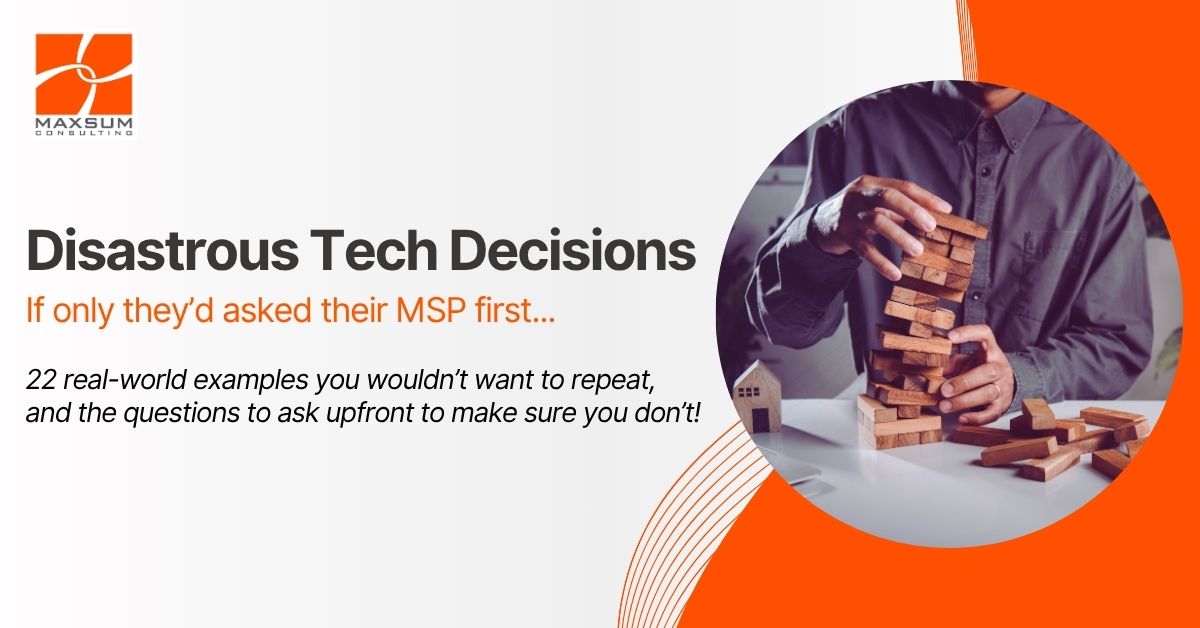In all 22 of these cases, a quick chat with their MSP first could have saved these clients from making disastrous tech decisions!
Before you click “Buy Now” or sign that contract, ask your MSP. They’re not just your tech support—they’re your strategic partner in avoiding disasters, saving money, and staying compliant. We’ve listed up some common examples of products or services that businesses often adopt without consulting their MSP — with costly and disruptive outcomes!
Software & Cloud Services
The tech tools that seem easy…until they break everything!
1. Cloud Storage Platforms (e.g., Dropbox, Google Drive)
- Example: A team starts using Dropbox to share files across departments.
- Disastrous Outcome: Files are stored outside company-approved systems, creating data silos and violating internal security policies.
- MSP Tip: Your MSP can recommend secure, compliant file-sharing solutions that integrate with your existing infrastructure and backup systems.
2. CRM or ERP Systems
- Example: Sales adopts a new CRM without IT involvement.
- Disastrous Outcome: The CRM doesn’t sync with the company’s email or accounting systems, causing data duplication and reporting errors.
- MSP Tip: MSPs assess compatibility and help ensure seamless integration with your existing tech stack.
3. Video Conferencing or Collaboration Tools (e.g., Zoom, Slack)
- Example: A department starts using Slack independently.
- Disastrous Outcome: Communication becomes fragmented, and sensitive data is shared without proper security controls.
- MSP Tip: MSPs help consolidate tools and enforce secure communication protocols across the organization.
4. Marketing Automation Tools (e.g., Mailchimp, ActiveCampaign)
- Example: Marketing launches a campaign using a new platform without IT review.
- Disastrous Outcome: The platform doesn’t sync with the CRM, leading to inconsistent customer data and data privacy compliance issues.
- MSP Tip: MSPs ensure proper data handling and integration with existing systems to maintain compliance and efficiency.
Hardware & Infrastructure
Those DIY Hardware deployments are bound to go disastrously wrong…
5. Consumer-Grade Network Equipment
- Example: A small office installs a retail-grade router to save money.
- Disastrous Outcome: The network becomes unstable and vulnerable to cyberattacks due to lack of enterprise-grade security features.
- MSP Tip: MSPs recommend scalable, secure networking solutions that support business continuity and remote management.
6. Unapproved Laptops & Desktops
- Example: Employees purchase their own laptops for work.
- Disastrous Outcome: Devices are incompatible with business software and lack endpoint protection, increasing support costs and security risks.
- MSP Tip: MSPs standardize hardware procurement to ensure compatibility, manageability, and security.
7. Standalone Servers
- Example: A department installs a local server for a project.
- Disastrous Outcome: The server isn’t backed up or monitored, creating a single point of failure and data loss risk.
- MSP Tip: MSPs design secure, redundant server environments that align with your disaster recovery strategy.
8. VoIP Phones and Communication Hardware
- Example: A business switches to a new VoIP provider and installs phones without IT input.
- Disastrous Outcome: Poor call quality and dropped calls due to network misconfiguration.
- MSP Tip: MSPs ensure proper network setup and QoS settings for reliable voice communication.
9. Printers and Multi-Function Devices
- Example: A team installs a new printer without IT involvement.
- Disastrous Outcome: The printer causes network conflicts and lacks secure printing protocols.
- MSP Tip: MSPs manage print environments to ensure security, efficiency, and centralized control.
10. Surveillance and Access Control Systems
- Example: Facilities installs IP cameras without consulting IT.
- Disastrous Outcome: Cameras are exposed to the internet without encryption, making them vulnerable to hacking.
- MSP Tip: MSPs ensure secure deployment and proper network segmentation for physical security systems.
Security & Data
Security risks you didn’t see coming – but your MSP would have!
11. Unvetted SaaS Tools
- Example: A team signs up for a new project management tool.
- Disastrous Outcome: The tool operates outside IT’s visibility, leading to data leaks and compliance violations.
- MSP Tip: MSPs vet tools for security and compliance, ensuring they fit within your governance framework.
12. BYOD (Bring Your Own Device) Policies
- Example: Staff begin using personal devices for work.
- Disastrous Outcome: Devices lack security controls, leading to malware infections and unauthorized access.
- MSP Tip: MSPs implement mobile device management (MDM) and enforce endpoint protection policies.
13. Unsecured Payment Gateways
- Example: Finance integrates a new payment processor without IT review.
- Disastrous Outcome: The gateway isn’t PCI compliant, exposing customer financial data.
- MSP Tip: MSPs ensure secure, compliant payment processing and proper integration with financial systems.
Compliance & Regulatory Standards
Bypassing your MSP can derail all your audit and compliance work
14. Non-Compliant Cloud Services
- Example: A department adopts a cloud app without checking ISO 27001 requirements.
- Disastrous Outcome: The app lacks encryption and access controls, resulting in audit failures.
- MSP Tip: MSPs ensure services meet ISO, NIST, and other security and compliance frameworks.
15. Missing Documentation and Evidence
- Example: A new system is deployed without updating compliance documentation.
- Disastrous Outcome: During an audit, the company can’t produce required logs or policies.
- MSP Tip: MSPs can maintain documentation and audit trails to keep you audit-ready.
16. Lack of Risk-Based Thinking
- Example: A new tool is introduced without a risk assessment.
- Disastrous Outcome: The tool introduces vulnerabilities that weren’t documented or mitigated.
- MSP Tip: MSPs conduct risk assessments and update your compliance documentation.
17. Employee Awareness and Training Gaps
- Example: Staff begin using a new platform without training.
- Disastrous Outcome: Misuse leads to data breaches and failed audits.
- MSP Tip: MSPs provide training and ensure new tools are rolled out with proper user education.
18. Fragmented Compliance Across Frameworks
- Example: A solution meets an industry standard but conflicts with ISO 27001 controls.
- Disastrous Outcome: Compliance efforts become duplicated and inconsistent.
- MSP Tip: MSPs harmonize compliance across multiple standards to reduce audit fatigue.
19. Failure to Maintain Continuous Compliance
- Example: A company adds new systems post-audit without IT oversight.
- Disastrous Outcome: The business is no longer audit-ready and must scramble to fix issues.
- MSP Tip: MSPs monitor changes and ensure ongoing compliance readiness.
Strategic & Financial Impact
The hidden costs of going it alone on tech decisions
20. Hidden Costs
- Example: A department purchases software without understanding licensing terms.
- Disastrous Outcome: Surprise fees and infrastructure upgrades inflate the budget.
- MSP Tip: MSPs help calculate total cost of ownership and suggest cost-effective alternatives.
21. Vendor Lock-In
- Example: A business commits to a proprietary platform without MSP input.
- Disastrous Outcome: Migration becomes expensive and difficult when the platform no longer meets needs.
- MSP Tip: MSPs help choose scalable, open solutions that support long-term flexibility.
22. Misaligned Tech with Business Goals
- Example: A team adopts a tool that doesn’t support remote work or growth plans.
- Disastrous Outcome: The tool becomes obsolete quickly, wasting time and resources.
- MSP Tip: MSPs align tech decisions with your strategic objectives to ensure every investment supports your future.
About to sign up to something new? Contact us first to ask us for advice.



